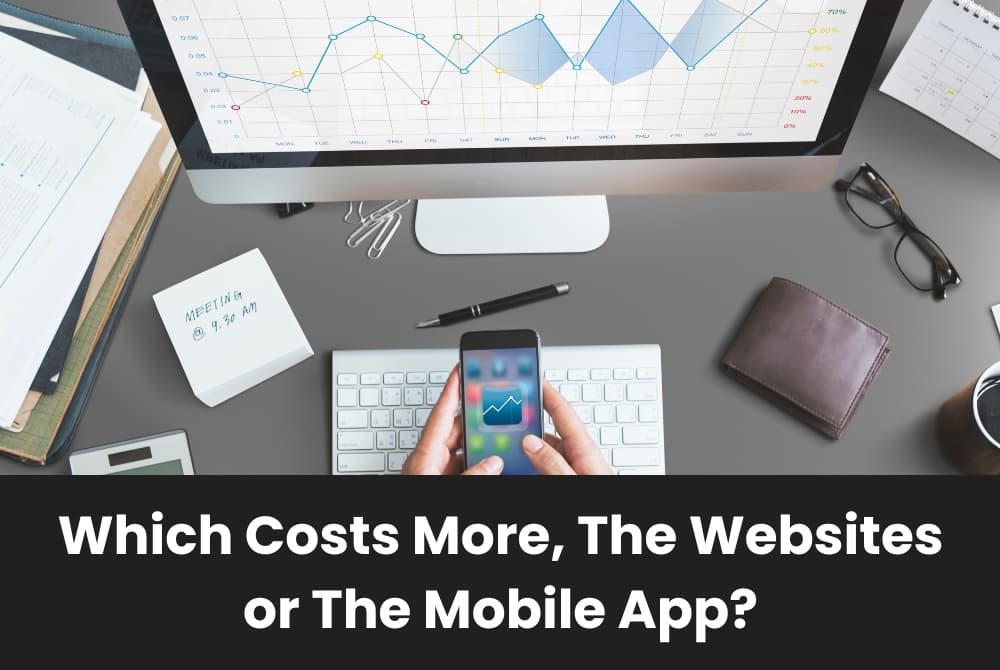Which Costs More, The Websites or The Mobile App?

Introduction
Several factors, each with associated costs, influence the decision of whether to invest in a mobile app or a website. Websites and mobile apps have different functions, meeting the needs of various user experiences and corporate goals. Cost factors include complexity in development, intricate design, maintenance needs, and platform-specific details. Websites are widely recognised for their affordability and ease of use, providing extensive coverage across various platforms.
Conversely, mobile applications offer a more customised and dynamic experience; however, because of platform-specific development, complex design requirements, and continuous maintenance requirements, they frequently result in higher development costs. In this investigation, we explore the subtle elements that impact the price of mobile apps and websites, assisting companies in making decisions that are well-informed and tailored to their particular objectives and target market.
Purpose and functionality
Whether it's a website or a mobile app, the function and goal of a digital platform have a big impact on the related expenses. Websites are usually used as informational centres or e-commerce platforms; their prices vary according to their level of complexity. Basic information-transmitting static websites are typically less expensive to develop than dynamic websites with databases and interactive elements. The more immersive and interactive user experience that mobile apps—created for particular platforms like iOS or Android—often offer raises the expense of development. The cost of developing a mobile app can also increase due to the complexity of features like offline functionality, real-time updates, or complex algorithms. Determining the costs involved and achieving the best possible balance between features and budgetary constraints depend greatly on having a clear understanding of the specific goals and functionalities required for a website or mobile application.
Deployment complexity
The cost of developing websites and mobile apps is largely dependent on how complex the project is. Different websites have different levels of complexity; they can be static pages or dynamic e-commerce platforms. While dynamic sites with complex features may require more resources and therefore incur higher costs, static sites are typically simpler and require less money to develop. On the other hand, the development of mobile apps must take into account platform-specific factors (iOS or Android), which raises complexity and costs. Because native apps are designed for a single platform, their complex functionality may make them more expensive than cross-platform or hybrid alternatives. The development complexity is a critical factor in determining the total costs of websites and mobile apps because it takes into account the complexities of coding, design, and guaranteeing seamless functionality across multiple devices.
Design and user interface
Website and mobile phone app development cost are greatly influenced by the design and user interface (UI) of a digital platform. For websites to provide a consistent user experience across devices, responsive design is necessary, and design customisation can affect costs. Interactive components, content-driven features, and aesthetically pleasing layouts add to the total cost. Conversely, mobile apps require platform-specific designs that adhere to iOS or Android guidelines. Development costs are increased by creating a UI that is fluid and easy to use as well as by adding unique animations and transitions. In order to create engaging and user-friendly digital experiences for their audience, businesses must strike an intricate balance between aesthetics and functionality. This is where unique design requirements come into play, impacting the overall cost of both websites and mobile apps.
Maintenance and updates
Throughout their lives, maintenance and updates have a significant impact on the costs of mobile apps and websites. Regular updates are necessary for websites' content, security patches, and possibly even redesigns. Costs associated with maintenance could include domain registration, hosting, and recurring optimisation improvements. On the other hand, mobile applications require frequent updates in order to incorporate new features, fix security flaws, and conform to new operating system versions. Continuous maintenance covers server costs related to backend services and guarantees the functionality and performance of the application. Technology is constantly changing, so businesses need to account for these recurring costs to maintain functionality, security, and relevance in the ever-changing digital landscape. This applies to both websites and mobile apps. In the end, a major portion of the total expenses related to improving and maintaining these digital platforms are determined by the type and frequency of updates.
Accessibility and reach
A number of important factors that affect the price of websites and mobile apps are their accessibility and reach on digital platforms. Websites ensure a wider reach by providing broad accessibility through browsers on different devices. They are more inclusive by nature, fitting in with a variety of platforms and audiences. On the other hand, mobile applications require separate development for iOS and Android due to their platform-specificity. This specificity can limit immediate reach, but it also offers a more personalised and engaging experience. Creating and maintaining two distinct codebases could drive up expenses. A website or mobile app should be chosen based on how well it balances universal accessibility with a more specialised, feature-rich experience. Companies need to carefully assess these variables in light of their target market and strategic goals in order to choose the best course of action that fits their spending plan and digital objectives.
Integration and compatibility
The price of websites and mobile apps is heavily influenced by compatibility and integration issues. Websites are excellent in allowing for flexibility and extensibility through integration with a wide range of third-party services, APIs, and plugins. However, more development work might be necessary to ensure compatibility across various browsers and devices. Mobile apps, on the other hand, make better use of device-specific features like sensors, GPS, and cameras. This increases development costs even though it improves functionality. One of the most important factors in figuring out the total cost of developing a mobile app is how to seamlessly integrate with native functionalities, which calls for specific coding and testing. For both websites and mobile apps, finding the ideal balance between compatibility and integration is crucial as companies look to offer robust functionality without sacrificing accessibility and user experience across various platforms.
Development team expertise
One of the main factors affecting the price of mobile apps and websites alike is the development team's experience. The creation of websites frequently makes use of common web development languages and frameworks (HTML, CSS, JavaScript), which expands the pool of developers and may result in more affordable prices. However, intricate designs or complex functionalities might call for specialised knowledge due to their inherent complexity. However, creating mobile apps necessitates knowing platform-specific languages (Kotlin or Java for Android, Swift for iOS), which can cost more to develop and often require specialised knowledge. Total costs can be affected by the platforms selected and the requirement for native development knowledge. When estimating costs and making sure the goals of a digital project are successfully realised, the degree of experience needed for website or mobile app development is a critical factor.
Testing and debugging
The stages of testing and debugging are crucial to the development process and have a big impact on the price of mobile apps and websites alike. Websites are thoroughly tested for functionality, responsiveness, and cross-browser compatibility. Although testing is crucial, it might not be as difficult as testing mobile apps. The challenge of testing mobile apps is more complex because they need to be thoroughly tested across a range of devices, screen sizes, and operating system versions. The cost of testing mobile apps is higher when debugging and optimising performance across multiple platforms. Testing must continue because app development is dynamic, requiring regular updates and the release of new devices. To guarantee a faultless user experience and reduce post-launch issues, websites and mobile apps must carefully balance extensive testing with financial considerations.
Time frame and development
The duration of development is a significant factor that affects how much websites and mobile apps cost. Compared to mobile apps, websites, especially the simpler ones, can be developed faster, providing faster development cycles that could result in overall cost savings. Timeliness is facilitated by the fact that website development is simple and there are many web developers available. On the other hand, creating mobile apps—especially those that work on several platforms—may take longer to develop, which will increase costs. Rapid development may result in greater expenses for fixes and updates after launch, so striking a balance between speed and quality is crucial. The completion timeline has a direct impact on the project's total cost, so companies need to carefully analyse their preferred launch dates while accounting for the complexity of developing a website or mobile app.
Industry and purpose
Website and mobile app development costs are largely determined by the type of digital platform and its intended use. Websites for brochures or informational purposes in sectors with simple requirements might be less expensive to develop. In contrast, the complexity of websites serving e-commerce, web applications, or industries with particular compliance standards may result in higher costs. Development costs may be impacted by the need for unique features in mobile apps created for niche markets like gaming, healthcare, or other sectors. Custom features, industry-specific compliance requirements, and security considerations all add to the total cost. Accurate cost estimation and making sure the website or mobile app successfully satisfies the specific requirements of the target audience and business objectives require an understanding of the nuances of the industry and the intended purpose of the digital platform.
Conclusion
In summary, the choice between purchasing a mobile app or a website is complex, with a number of variables affecting the related expenses. Websites are great for content-driven or informational purposes because of their affordability and wide accessibility. Websites' total expenses are influenced by the complexity of their development, intricate designs, and ongoing maintenance requirements. However, because they require constant updates, have complex functionalities, and are platform-specific, mobile apps—which provide a more customised and interactive user experience—generally have higher development costs. The decision ultimately comes down to a company's budget, target market, and particular goals. A successful digital project necessitates striking a balance between the desired features and the available resources. To decide which better fits their strategic objectives and user engagement goals—a mobile app or a website—businesses must carefully consider their own requirements.
Read also: Cost to Hire Mobile App Developer for Application Development
Read also: Top 9 Reasons to Invest in eCommerce Website Development
Read also: Top 13 Steps to Hire a Mobile App Development Company
Recent Blogs

Proven Strategies to Increase Organic Traffic to Your eCommerce Store

What Is Digital Marketing, Why Is It Important And How Is It Better Than Traditional Marketing
